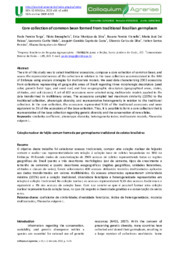Core collection of common bean formed from traditional Brazilian germplasm.
Core collection of common bean formed from traditional Brazilian germplasm.
Author(s): TORGA, P. P.; BRESEGHELLO, F.; SILVA, E. M. da; VIANELLO, R. P.; DEL PELOSO, M. J.; MELO, L. C.; COSTA, J. G. C. da; SILVA, S. C. da; PEREIRA, H. S.; ABREU, A. G. de
Summary: The aim of this study was to select traditional accessions, compose a core collection of common bean, and assess the representativeness of the collection in relation to the base collection accommodated in the BAG of Embrapausing analysis strategies for multivariate models. We useddata characterizing 2903 accessions fromcollections representing all geographic areas of Brazil regarding three morphologic descriptors (seed color, growthhabittype, and seed size) and four ecogeographicdescriptors (geographical areas, states, altitudes, and soil classes). A set of400 accessions were selected using multivariate models applied to the data transformed in multibinary values. The accessions sampled had maximum similarity (100%) tothe traditional collection, phenotypic diversity, and representative heterogeneity in relation to the traditional collection. In the core collection, the accessions represented 9.5% of the traditional accessions and were equivalent to 3% of the accessions of the base collection. Thus, it is possible to form a core collection that is representative of the base collection regarding genetic diversity and the conservation of rare alleles.
Publication year: 2022
Types of publication: Journal article
Unit: Embrapa Rice & Beans
Observation
Some of Embrapa's publications are published as ePub files. To read them, use or download one of the following free software options to your computer or mobile device. Android: Google Play Books; IOS: iBooks; Windows and Linux: Calibre.
Access other publications
Access the Agricultural Research Database (BDPA) to consult Embrapa's full library collection and records.
Visit Embrapa Bookstore to purchase books and other publications sold by Embrapa.

